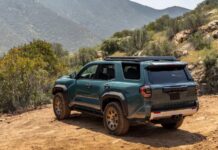The Ford Ranger and Everest SUVs will undergo a powertrain change in 2026, as Ford Australia phases out the widely popular Bi-Turbo 2.0-litre four-cylinder diesel engine globally. This shift comes amidst increasingly stringent emissions regulations and evolving market demands.
Impact on Ranger and Everest Models
Currently, the Bi-Turbo diesel serves as the mid-range engine option for the Ranger, Australia’s best-selling vehicle for the past two years, and the entry-level powertrain in the related Everest SUV. The Everest was also recently crowned Australia’s most popular large SUV in 2024.
The discontinuation of the Bi-Turbo will be accompanied by two key changes: a revised version of the entry-level single-turbo 2.0-litre diesel, and increased availability of the 3.0-litre turbo-diesel V6. Notably, the single-turbo engine will be offered in the Everest for the first time, replacing the Bi-Turbo as the base engine option.
Powertrain Enhancements and Specifications
The updated single-turbo engine will feature a new fuel-injection system and an upgraded timing chain, promising improved durability and performance. Crucially, it will also swap its existing six-speed automatic transmission for the same 10-speed auto currently paired with the V6 and the outgoing Bi-Turbo.
While Ford Australia has yet to confirm the specific power outputs for the revised engine, these enhancements suggest a significant improvement over the current model, which delivers 125kW of power and 405Nm of torque. For comparison, the Bi-Turbo currently produces 154kW and 500Nm.
There remains uncertainty regarding the engine’s compliance with the upcoming Euro 6d emissions standard and the requirement for AdBlue.
Context: Emissions Regulations and Market Trends
This powertrain shift is primarily driven by the introduction of the New Vehicle Efficiency Standard (NVES) and the upcoming Euro 6d emissions standard in Australia. NVES imposes a limit of 180g/km for Type 2 vehicles—which includes utes and large off-roaders like the Ranger and Everest—starting in 2026.
The Euro 6d standard, which replaces the current Euro 5 measure, will apply to all new cars sold from 2028 and requires stricter emissions control measures. These regulations incentivize automakers to reduce vehicle emissions, influencing powertrain choices and driving the shift towards more efficient engines.
Furthermore, the introduction of the Ranger plug-in hybrid (PHEV) offers a crucial counterbalance. Despite lower sales volumes, the PHEV’s 66g/km CO2 emissions significantly help offset the higher emissions of the diesel models. The current diesel engines range from 181g/km to 195g/km (single-turbo), 182-189g/km (Bi-Turbo), 222g/km (diesel V6) and 262g/km (petrol V6 Raptor).
Ranger and Everest Trim Levels Affected
The discontinuation of the Bi-Turbo engine will alter trim availability for both models. Currently, the single-turbo is exclusive to the Ranger XL, while the Bi-Turbo is offered in XL, XLS, XLT, Sport and Wildtrak trims. The V6 is available in XLT, Sport, Wildtrak and Platinum. In the Everest, the Bi-Turbo is found in Ambiente and Trend, while the V6 is exclusive to Sport, Tremor, Wildtrak and Platinum.
The Raptor, with its twin-turbo 3.0-litre petrol V6, will continue unaffected, alongside the existing plug-in hybrid versions.
Expected Timeline and Further Details
First deliveries of the updated Ranger and Everest lineups are anticipated in the first half of 2026. Ford Australia has promised to release more details closer to the launch. >The transition from the Bi-Turbo engine marks a significant update to Ford’s popular Ranger and Everest, aligning with stricter environmental standards while incorporating improvements to performance and availability.




















